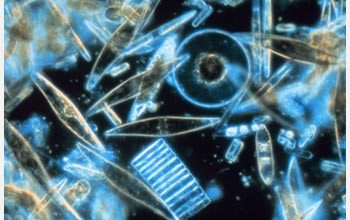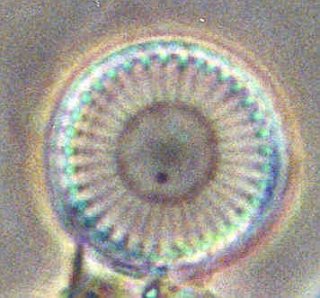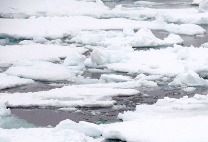
Habitat
Diatom are one of the most prolific
phototrophic or ganisms
on the plant. One of the primary reasons that they are able to
do this is because the fact that they can live virtually
everywhere and they do so in substantial numbers.
ganisms
on the plant. One of the primary reasons that they are able to
do this is because the fact that they can live virtually
everywhere and they do so in substantial numbers.
It’s impressive to think that they are one of the few
organisms that can live in open ocean, polar waters, tropical
waters, all fresh water areas, soil, snow and even glacial ice.
The different species of diatoms though have to develop
different adaptations to survive within each environment.
Open Ocean: The species that live in Open Ocean diatoms have a
lesser pressure from predation then in some other environments,
but they have a greater pressure from the lack of some key
element that they need for growth. The largest is often iron and
diatoms develop special mechanism to obtain and retain iron. But
it still causes a large limitation to their growth. Another key
element that diatoms also will experience a lack of is nitrogen
in a usable from. Although, this isn’t always a large problem
especially in areas of Open Ocean where there is also
populations of cyanobateria that will produce nitrate the
diatoms will be able to use. Then the last major element that
they need that may end up being a restricting agent is silicon
concentration in the water. Although, silicon concentrations are
almost in sufficient supply if it is in short supply then
diatoms will be unable to reproduce at a sufficient rate because
they will be unable to produce their famous frustules. Also,
since there isn’t a complete dissociation of all the dead and
discarded diatom frustules there is a mild decrease in the
concentration of silicon in the environment. Although, they are
the most dominate primary producers of these ecosystems.

Polar Water: The species that live in polar waters are going to
often have ample nutrients due to ocean currents and the
abundance of life adding iron and nitrogen to the water though
various means. But they have to adapt to have a good portion of
the year being enveloped in darkness and not being able to
photosynthesis. They either develop into vegetative cells or
they resort to heterotrophic methods. This allows them to be the
primary production in polar ecosystems.
Tropical Waters: The species that live in tropical waters have a
large amount of competition and probably the greatest pressure
from predation than any other habitat. They typically have
slightly thick frustules and have protecting adaptations within
their frustules to prevent predation. They don’t have to worry
abou t
any nutrients though since tropical waters have typically high
concentrations of just about all the element that organisms need
to live. The dominance of diatoms will vary in tropical waters.
The dominant primary producers in these will often be some form
of algae, or if it’s a reef system it will often be the
dinoflagellates that are in association with the coral. Even so
diatoms typically have a strong foot hold in these waters and
are able to be very prevalent and end up still producing a large
degree of the net primary production.
t
any nutrients though since tropical waters have typically high
concentrations of just about all the element that organisms need
to live. The dominance of diatoms will vary in tropical waters.
The dominant primary producers in these will often be some form
of algae, or if it’s a reef system it will often be the
dinoflagellates that are in association with the coral. Even so
diatoms typically have a strong foot hold in these waters and
are able to be very prevalent and end up still producing a large
degree of the net primary production.
Fresh Water: The fresh water habitats of diatoms’ include lakes,
rivers, streams, marshes, swamps, est. they grow in all fresh
water habitats. There are almost never special adaptations for
obtaining the scarce elements that they need for growth.
Although, if they are in rivers or streams they often have to develop
mechanisms to allow them to stay relatively steady and prevent
them all form getting washed down the river. These often come in
forms of the diatoms attaching themselves to various surfaces
that will allow them to be steady or they will grow in the upper
part of the sediment which allows light to still permeate down
to them but prevents them from washing away. Then in lakes,
marshes and swamps they don’t typically have any issues with
growth because there is relatively little flow to the water so
their basic buoyancy is enough to allow them to stay in the
areas with relatively no problem. In these habitats though do
have a fair competition, which comes from various fresh water
plants such as water lilies, cat tails, duck weed and
they are in rivers or streams they often have to develop
mechanisms to allow them to stay relatively steady and prevent
them all form getting washed down the river. These often come in
forms of the diatoms attaching themselves to various surfaces
that will allow them to be steady or they will grow in the upper
part of the sediment which allows light to still permeate down
to them but prevents them from washing away. Then in lakes,
marshes and swamps they don’t typically have any issues with
growth because there is relatively little flow to the water so
their basic buoyancy is enough to allow them to stay in the
areas with relatively no problem. In these habitats though do
have a fair competition, which comes from various fresh water
plants such as water lilies, cat tails, duck weed and others. The competition isn’t extremely intense though so
because light is still able to move past the plants and still
reach them, as well as, the fact that diatoms are able to use
some wave lengths of light that plants aren’t able to use very
well. Also, diatoms are able to photosynthesis year around if
the light is available. This allows diatoms to be very effect in
these habitats.
others. The competition isn’t extremely intense though so
because light is still able to move past the plants and still
reach them, as well as, the fact that diatoms are able to use
some wave lengths of light that plants aren’t able to use very
well. Also, diatoms are able to photosynthesis year around if
the light is available. This allows diatoms to be very effect in
these habitats.
Soil: Some species of diatoms are able to grow in moist soils.
They have to develop new mechanisms that allow them to withstand
a more dynamic temperature are as well as mechanisms that allow
them to maintain water more effectively. They are often growing
in field soils rather than wooded soils because of the light and
they also usually are pennale species that are able to move,
(more about movement in facts), usually by a slimy substance
that they excrete. Well there are very few of these species, it
is impressive that they are able to establish themselves in such
a large amount of soil.

Glacial Ice: There have been diatoms found in glacial ice. This
is impressive. They have to live in extremely limited
environment. Having little silica, iron, nitrogen and sometimes
even gasses they are inherently smaller and extremely slow
growing. They also have to be able to form a vegetative cyst
whenever there isn’t enough light present which would allow them
to produce energy and all their organic molecules. Simply an
example of how far they can go and how many places that they are
able to grow.
To Adaptation